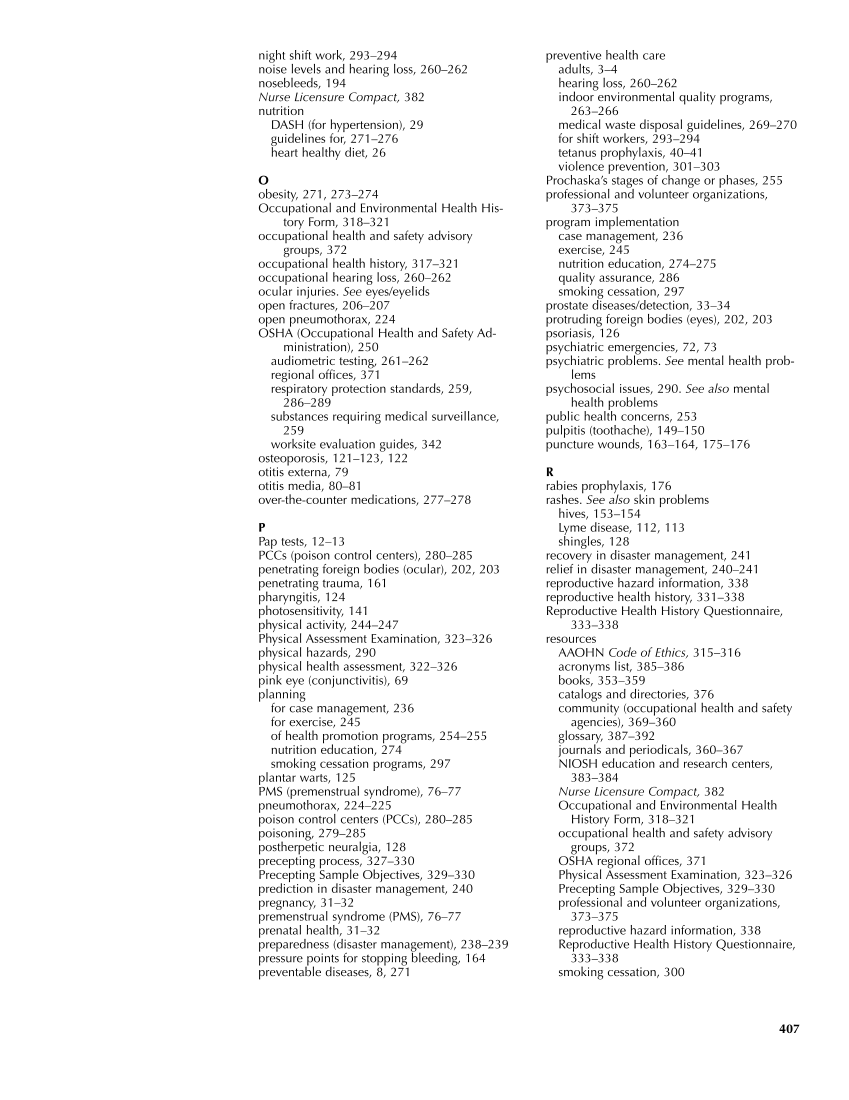night shift work, 293–294 noise levels and hearing loss, 260–262 nosebleeds, 194 Nurse Licensure Compact, 382 nutrition DASH (for hypertension), 29 guidelines for, 271–276 heart healthy diet, 26 O obesity, 271, 273–274 Occupational and Environmental Health His- tory Form, 318–321 occupational health and safety advisory groups, 372 occupational health history, 317–321 occupational hearing loss, 260–262 ocular injuries. See eyes/eyelids open fractures, 206–207 open pneumothorax, 224 OSHA (Occupational Health and Safety Ad- ministration), 250 audiometric testing, 261–262 regional offices, 371 respiratory protection standards, 259, 286–289 substances requiring medical surveillance, 259 worksite evaluation guides, 342 osteoporosis, 121–123, 122 otitis externa, 79 otitis media, 80–81 over-the-counter medications, 277–278 P Pap tests, 12–13 PCCs (poison control centers), 280–285 penetrating foreign bodies (ocular), 202, 203 penetrating trauma, 161 pharyngitis, 124 photosensitivity, 141 physical activity, 244–247 Physical Assessment Examination, 323–326 physical hazards, 290 physical health assessment, 322–326 pink eye (conjunctivitis), 69 planning for case management, 236 for exercise, 245 of health promotion programs, 254–255 nutrition education, 274 smoking cessation programs, 297 plantar warts, 125 PMS (premenstrual syndrome), 76–77 pneumothorax, 224–225 poison control centers (PCCs), 280–285 poisoning, 279–285 postherpetic neuralgia, 128 precepting process, 327–330 Precepting Sample Objectives, 329–330 prediction in disaster management, 240 pregnancy, 31–32 premenstrual syndrome (PMS), 76–77 prenatal health, 31–32 preparedness (disaster management), 238–239 pressure points for stopping bleeding, 164 preventable diseases, 8, 271 preventive health care adults, 3–4 hearing loss, 260–262 indoor environmental quality programs, 263–266 medical waste disposal guidelines, 269–270 for shift workers, 293–294 tetanus prophylaxis, 40–41 violence prevention, 301–303 Prochaska’s stages of change or phases, 255 professional and volunteer organizations, 373–375 program implementation case management, 236 exercise, 245 nutrition education, 274–275 quality assurance, 286 smoking cessation, 297 prostate diseases/detection, 33–34 protruding foreign bodies (eyes), 202, 203 psoriasis, 126 psychiatric emergencies, 72, 73 psychiatric problems. See mental health prob- lems psychosocial issues, 290. See also mental health problems public health concerns, 253 pulpitis (toothache), 149–150 puncture wounds, 163–164, 175–176 R rabies prophylaxis, 176 rashes. See also skin problems hives, 153–154 Lyme disease, 112, 113 shingles, 128 recovery in disaster management, 241 relief in disaster management, 240–241 reproductive hazard information, 338 reproductive health history, 331–338 Reproductive Health History Questionnaire, 333–338 resources AAOHN Code of Ethics, 315–316 acronyms list, 385–386 books, 353–359 catalogs and directories, 376 community (occupational health and safety agencies), 369–360 glossary, 387–392 journals and periodicals, 360–367 NIOSH education and research centers, 383–384 Nurse Licensure Compact, 382 Occupational and Environmental Health History Form, 318–321 occupational health and safety advisory groups, 372 OSHA regional offices, 371 Physical Assessment Examination, 323–326 Precepting Sample Objectives, 329–330 professional and volunteer organizations, 373–375 reproductive hazard information, 338 Reproductive Health History Questionnaire, 333–338 smoking cessation, 300 407
Purchased from OEM Press by (ge corporate access). (C) 2013 OEM Health Information, Inc. All rights reserved.












































































































































































































































































































































































































































